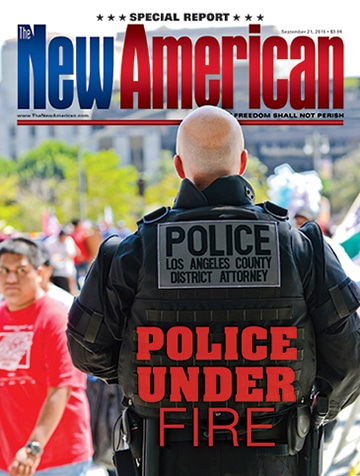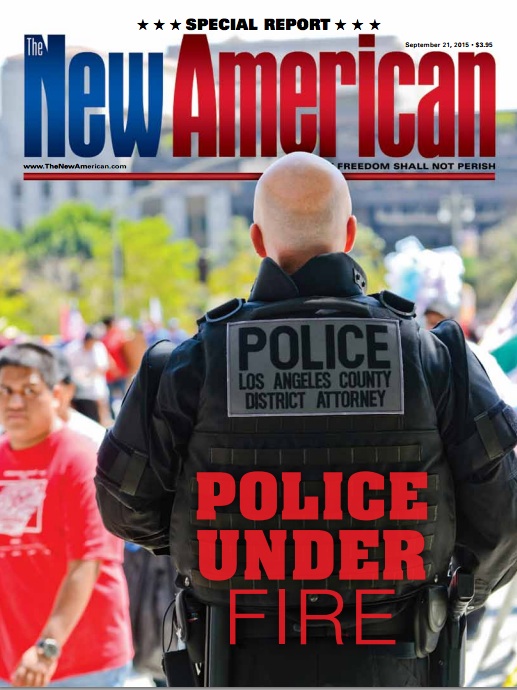What About Police Brutality?
On July 11, 2015, Madison County, Indiana, sheriff’s deputies pulled over Ewart Kenneth Johnson, a 51-year-old black man. Johnson’s blood alcohol level at the time of his arrest was five times the legal limit. Later that night, while being booked into the Madison County jail, Johnson claims, four deputies beat him, resulting in a gash on his head and a severely swollen face.
Stories such as Johnson’s seem to surface every day. Headlines from coast to coast report cases of police brutality (often involving white police officers and black victims). This case has a different ending, however, one that doesn’t make it to the front page.
Video Vanquishes Lies
Rather than jump blindly to the defense of his deputies, Madison County Sheriff Scott Mellinger handled Johnson’s accusations in a way that should be followed by his fellow sheriffs throughout the country.
“We all know that nationally, there’s been all kinds of police-community antagonistic situations, and I wanted to get to the bottom of it,” Mellinger said, as reported in local Indianapolis media. “We need to go the extra yard and show people that number one, we have nothing to hide, and number two, as sheriff, I want transparency.”
Transparency. Going the extra yard. These are not the type of actions that will attract the rabid anti-cop crusaders, but they are exactly the type of responsible reactions to charges of police brutality that should be reported as widely as are those of the less reasonable sort.
True to his word, Mellinger handed over the investigation of the case to the Indiana State Police, completely removing his own department from the matter, thus heading off potential claims of pro-police bias or partiality. During the investigation, surveillance video was released that showed that, contrary to Johnson’s claims, the injuries he claimed were inflicted by the arresting officers were already clearly visible before Johnson was booked. When confronted with the video revealing his pre-arrest appearance, Johnson said he “must have dreamt” that he was beaten by deputies and he “made a big mistake.”
In the current socially combustible climate, this is the sort of “mistake” that could end careers and ignite potentially lethal protests. Had Sheriff Mellinger jumped to the blind defense of his officers, the firestorm could have flared and the facts would have been obscured by the tear-gas smoke.
Perhaps the most widely reported incident of a police officer exonerated of misuse of deadly force was that of Ferguson, Missouri, Officer Darren Wilson. In March, the Justice Department cleared Wilson of charges that he violated the civil rights of Michael Brown, who was killed last August. The New York Times reported that the 86-page report issued by the Justice Department
detailed and evaluated the testimony of more than 40 witnesses, the Justice Department largely corroborated or found little credible evidence to contradict the account of the officer, Darren Wilson, who is white.
Versions of events that sharply conflicted with Mr. Wilson’s were largely inconsistent with forensic evidence or with the witnesses’ previous statements, the report said. And in some cases, witnesses whose accounts supported Mr. Wilson said they had been afraid to come forth or tell the truth because they feared reprisals from the enraged community.
Though the dismissal of charges against Wilson didn’t go unchallenged, and the agitators didn’t go away quietly, content with the clearing of Wilson’s name, the situation demonstrates the difficulty of clearly discerning guilt and innocence in this volatile climate where acquittal and conviction can create combustible interactions between public servants and members of the public.
While Madison County deserves credit for its professionalism and transparency, too often the charges of police brutality aren’t so easily disproved and aren’t the result of “dreams,” but are nightmares that have become very real.
In Denver, Colorado, for example, a video not only didn’t exonerate police accused of beating a citizen, but revealed that their brutality was worse than expected. In July 2009, police subdued and handcuffed four women. Later, the women claimed the cops roughly threw them to the ground, sprayed them with mace, and continued beating them once they were down. The women, insisting they did nothing to deserve such savagery, filed a formal complaint with the Denver Police Department, accusing the officers of using excessive force. The officers adamantly denied the charges and a believing public backed them all the way.
That is until a video surfaced two years later revealing the truth of victims’ allegations and showing the officers lied about their treatment of the women they arrested. Before the video came to light, the officers accused of brutality claimed that the women attacked them and that they were quickly surrounded by a mob. None of that appeared on the video, however.
The city awarded the women $360,000, but the policemen who beat them and then lied about it were put back on the streets after the furor died down, this time as agents of the Denver Civil Service Commission.
Remarkably, this betrayal of the public trust went unnoticed until August 2015, when the women pushed back again, resulting in the dismissal of one of the officers. The other attacker had quit in 2013.
Despite the right resolution of this case, many other cases of police brutality go unpunished and, on the other hand, many false charges of police-inflicted injury are accepted without appropriate inquiry.
One of the most notorious examples of verifiable violence committed by cops against those undeserving of any level of abuse happened in Cornelia, Georgia, and left a toddler near death, horribly injured, and disfigured. Bounkham Phonesavanh was 19 months old and asleep in his crib when a sheriff’s SWAT team broke open the front door in the early morning hours on May 28, 2014 and threw a flash-bang grenade into the front room. His mother, father, and three sisters were in the room as well. The grenade attack came during the execution of a “no-knock” warrant, supposedly based on an anonymous tip regarding an alleged $50 drug deal.
“Everyone’s sleeping. There’s a loud bang and a bright light,” the boy’s mother, Alecia Phonesavanh, told local news station WSB-TV. “The cops threw that grenade in the door without looking first, and it landed right in the playpen and exploded on his pillow right in his face.”
As a result of injuries from the SWAT team’s tactics, Bounkham was placed in a medically induced coma. “It blew open his face and his chest,” the boy’s mother told the Atlanta Journal-Constitution outside Grady Memorial Hospital. “Everybody was asleep. It’s not like anyone was trying to fight.”
According to an article in the U.K. Daily Mail, Bounkham Phonesavanh has endured some 10 surgeries costing more than a million dollars, “His nerve endings are dead around his mouth and chest, so they will not be able to properly develop as they are supposed to, so they [surgeons] will have to go in and do stretching and grafts.” He’ll likely need surgery at least every other year as he grows.
Do’s and Don’ts of Intervention
While public outcry against abuses of power by those carrying guns and charged with “serving and protecting” their fellow citizens is understandable and often justified, too often those demanding punishment of offending officers also demand that the federal government get involved to crack down on the rogue cops.
On the other side, the segment of society sympathetic to the perceived plight of police and hostile to those claiming abuse at their hands also petition the federal government, demanding that they send local law enforcement more powerful weapons to help them fight the foes of law and order and keep police on the street safe from rocks thrown by rioters.
Constitutionalists on either side of the issue should recognize the problem with both reactions: increased federal control over local law enforcement.
Of course, the federal government gets what it wants regardless of who wins the fight for “safer streets.”
A key plank of the Obama administration platform seems to be the conversion of the local police into a sixth branch of the U.S. armed forces, and all the attention paid to charges of police brutality and the riots that so often erupt is pushing that agenda forward at breakneck speed.
Cash-strapped local law enforcement gobbles up the federal “grants,” purchasing military-grade vehicles, weapons, ammunition, and surveillance technology that would make the National Security Agency (NSA) proud. In December 2014, President Obama proposed $263 million in federal funding for local law enforcement, which includes $75 million for body-worn video cameras for police officers, the latest panacea for police abuse. Budgetary considerations and the constitutional federalism issues aside, the body cam, like the dashcams mounted in many police cruisers and the audio recorders already worn by many peace officers, can offer some measure of accountability — both for the peace officers and those who accuse them of abuse. It is worth noting that available evidence indicates that more often than not, dash-cam and body-cam videos exculpate, rather than convict, officers of wrongdoing.
The recent case of liberal Connecticut activist Professor Minati Roychoudhuri, who falsely accused a state trooper of racial profiling, is one of many in which video/audio recordings have shown accusations of police misconduct to be totally false. The recordings show Trooper John Such was courteous and professional, and the professor’s public accusations were false and malicious. Roychoudhuri is being prosecuted for her demonstrably false charges against the trooper. In other similar recent examples, police videos have exonerated officers in “celebrity” racism/brutality accusation cases, such as these: in Texas, Democratic state representative Garnet Coleman; California, actress Taraji Henson; Kansas, activist John Sherman; and California, actress Daniele Watts. Many additional cases have shown that ideologues with a political agenda, as well as opportunists attempting to avoid the consequences of their criminal activities, have adopted the practice of hollering “racism” and “brutality” at the first contact with police officers.
While the campaigns for body cams is relatively new, the campaign for establishing “civilian review boards” has been underway since the 1930s — when it was launched by the Communist Party. The term “civilian review” is deceptively appealing, and we already have it in the form of civilian officials elected by the people and other civilian appointees and institutions established under state constitutions and county/city charters: state and county grand juries, county commissions, city councils, mayors, county sheriffs, etc. The Communist Party and its fellow travelers intended to undermine this constitutional civilian process by inserting over the police and sheriffs an unelected board of activists (whom they intended to control). Unfortunately, this subversive program has now been instituted in more than 100 U.S. cities.
As it stands now, the multi-pronged war against locally-controlled police is dangerously advanced. Unless citizens awaken to this fact and reverse the trend, we will find ourselves accelerating faster down the trail to tyranny.



